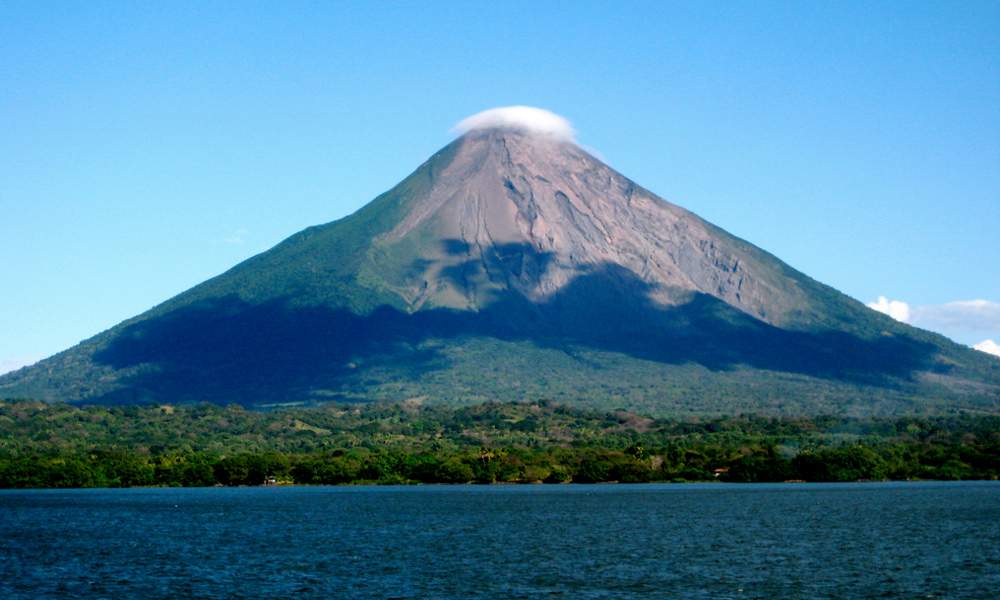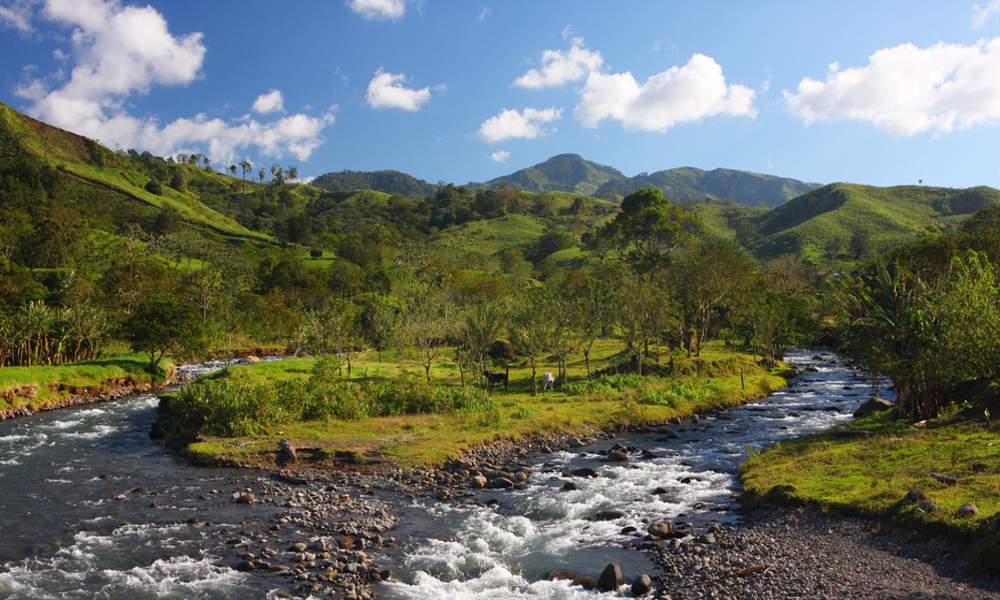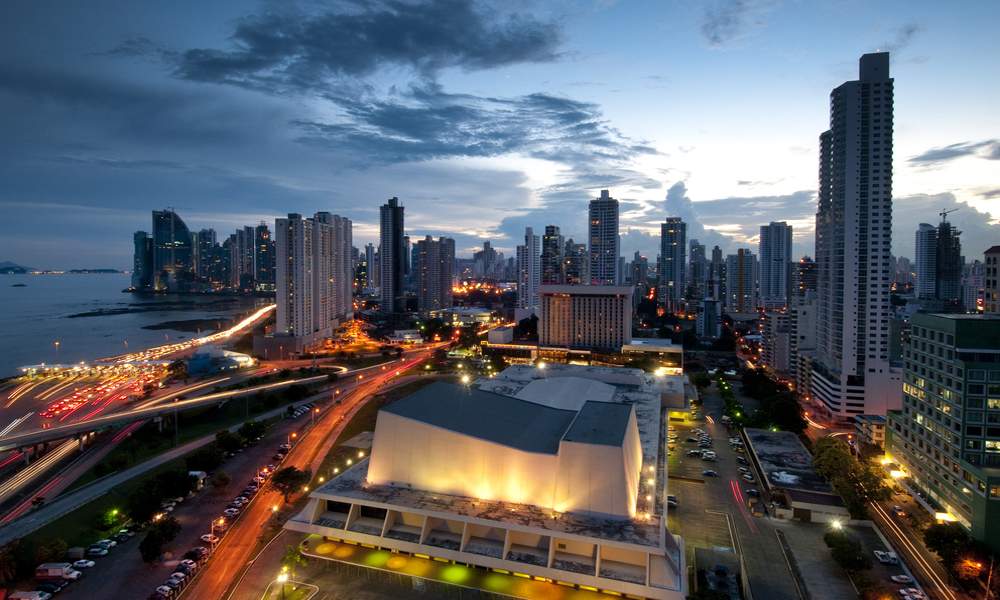Where to go
In this part, we will look at the highlights in Honduras, Nicaragua, Costa Rica, and Panama, as well as some off-the-beaten track spots.
As mentioned in Part 1, some people have rushed through Central America in under a month, while others have lavishly lingered in the region for over six months. Skipping a few countries or applying a grueling itinerary, you can see a lot in a short space, but as usual, the longer you stay, the more you will see.
Honduras

Honduras, along with El Salvador, is one of the most frequently missed parts of Central America. Some skip it because of concerns about danger, political unrest, and a lack of substantive infrastructure (which can all be a reality at times), while others pass it by purely due to lack of time. However, the Bay Islands are one of Central America’s best attributes, and the country can also lay claim to mysterious Maya ruins and rugged cloud forest. Those that visit often stay longer than intended and are overwhelmingly pleased they didn’t skip past Central America’s second largest country.
Highlights
- Utila: The Bay Islands are the magnetic draw in Honduras, and there are three to choose from, though the most indie traveler friendly is Utila. A diver’s paradise and party island, you’ll want to spend equal time with your head in the water and your feet tapping on dry land. If you’re around in August, don’t miss Sun Jam, Central America’s largest electronic music festival.
- Copán Ruinas: The hieroglyphics and near perfect sculptures are what set the Maya ruins at Copán aside from the rest in Central America. They also happen to be the largest in Honduras.
- Lago de Yojoa: Hiking amid beautiful mountainous scenery is on the menu at Honduras’ largest natural lake. Ruins speckle the lakeshores and wildlife is plentiful.
Off the beaten path
- La Moskitia: Despite being Central America’s largest rainforest, La Moskitia has few well-trodden paths. This is exciting for exploration but can be costly to get to by tour, boat,or air.
Costs
As is common with popular dive islands, the costs of Utila are more than visiting the mainland, but the prices are still more budget friendly than neighboring Roatán. In most places $10USD will get you a bed for the night, while the mainland has some finds as low as $5.
Bus prices differ vastly between the chicken buses and the first class services, but you will also notice a vast difference in comfort. As with much of Central America, good, cheap street food is available for a couple of dollars or less, and even an inexpensive restaurant meal will come in under $10 while the local beer is impressively cheap at around $1 for half a liter. If you’re interested in diving, Honduras is your cheaper option compared to Belize.
Weather
Altitude is one of the biggest factors affecting the weather in Honduras, which can change dramatically between the hot and humid Caribbean coast and the western highlands.
Unlike much of Central America, Honduras’ Caribbean coast sees its rainiest time between September and January, while on the Pacific Coast November to April marks the dry season. Keep an eye on the weather, particularly during the rainy and hurricane season (June to November), as both flooding and hurricanes have previously caused extensive damage to the country.
Transport
Although Tegucigalpa is the capital, San Pedro Sula is one of the main transport hubs, and the place you’re most likely to pass through time and again during your jaunt to Honduras. If you do catch a flight, it also has the bigger and better airport.
Despite its large coastal stretches, boat access to Honduras from other countries is pretty much limited to the infrequent route from Belize. Therefore, getting to Honduras is usually by bus, and if you prefer a direct route, Tica buses will do the job. King Quality is an alternative company running similar routes.
Within Honduras, buses and boat (to the Bay Islands) are the most common ways of getting around. Wonderfully cheap chicken buses will take you to most destinations for a few dollars. There is also a first class services by Hedman Alas, but prices rocket with tickets costing between $20 and $70 for routes within the country. Ferries to the Bay Islands run each day.
Honduras is one of the few Central American countries where it is worth checking out local airfares, especially if you are short on time or traveling a fair distance, like to Moskitia. Prices aren’t rock bottom, but with enough advance booking can come in under $100.
Read Paradise on a Budget: Eco Retreats that Won’t Break the Bank
Nicaragua

Nicaragua is my personal favorite out of all of Central America, and I doubt I’m the only one who feels that way. Volcanoes to play on, beaches to chill out at, and colonial culture make Nicaragua interesting, but it is the comparatively low level of tourist development providing a glimpse of real life that makes Nicaragua seem so special. Roads are dusty and often unpaved, water can be intermittent, and so can electricity, which all blends together to add to the fun.
Highlights
- Granada: Arguably Nicaragua’s most beautiful colonial city, Granada is a great place to linger and meet the local culture. The city is colorful and cast against a dramatic volcanic backdrop while Lake Managua offers the chance to explore the tiny lake islands.
- San Juan Del Sur: Still sufficiently lacking in tourism to feel laid back, San Juan is a perfect indie beach hangout. The surf is good for newbies, but don’t expect the pure colors of the Caribbean.
- The Corn Islands: Perfectly underdeveloped, the Corn Islands are the very definition of Caribbean paradise. Virgin beaches and translucent waters make the trek and cost worthwhile.
Off the beaten path
- Isla Ometepe: Towering out of Lake Nicaragua are two volcanoes that are linked together by the magma that cooled to form the island. As well as the views, a string of sandy beaches, and low levels of tourism, the volcanoes are screaming out to be climbed.
Costs
Nicaragua is one of the cheapest countries to travel to in Central America. If you’re spending $10 or more on accommodation, you’re looking at something above average ($5-$7 is more usual). The same goes with food. Even in a basic restaurant, the standard chicken, rice, and beans menu is unlikely to cost more than $3, while street eats can come in under $1. The local brew, Tonia, is as cheap as water in other parts of the world, but don’t overlook the local rum, Flor de Caña, which is both cheap and good (a rare combination).
Like elsewhere, the chicken buses can take you the best part of a day for under $5. Absent a mass of activities and flights to the Corn Islands you can easily get by on under $30 a day. In short, if you’re looking to experience Central America on a budget, plan to spend a fair amount of time in Nicaragua.
Weather
Once again you’re in volcano country, and the weather will fluctuate according to whether you are in the highlands or the lowlands.
As a general rule, November to April marks the hot and dry season while May to October sees the rain move in, with some torrential downpours. June to September is also the hurricane season, so keep an eye on the local weather reports as past hurricanes have been known to inflict damage and, if nothing else, interfere with transport.
Transport
Chicken buses are once again the most common way to get around Nicaragua. Try and get on early or you risk a back-aching journey standing for a few hours. Tica Bus, Kings Quality, and Transnica do the long distance-inter-country thing, at the usual increased (but often worth it) price, while microbuses are a great alternative. Costing only a little more than the chicken buses but taking much fewer stops, these minibuses run some of the main routes between the bigger towns and cities.
Flights are worth considering, particularly if the Corn Islands are on your itinerary (land and boat can take a day to get there), but expect to pay around $160 return, and be prepared to book in advance.
Read Caribbean Without the Cost: 5 Great Beach Spots in Latin America
Costa Rica

Famed for its cloud forests, jungle, and coffee plantations, Costa Rica is a natural attraction, and not just for indie travelers. Any destination that makes it into the honeymoon brochures is going to have a high number of five-star resorts, and the associated tourist levels and higher prices that come with them. Many backpackers are put off by this, but try not to be. There are still pockets where indie travelers hang out untouched by mass tourism, and the sights really are too beautiful to let this country simply pass you by.
Highlights
- Puerto Viejo: Chill out in a hammock hostel, stroll through the reggae-blasting sandy streets, and relax in this small, southern corner of Costa Rica’s Caribbean coast. Tourism is trying to move in, but Puerto Viejo is putting up a good fight.
- Monteverde: Nature and adrenaline are at the heart of Monteverde. Take a canopy tour through cloud forest or go zip-lining and horse riding (not at the same time). This part of Costa Rica merits the spend.
- Santa Teresa: With some of the best sunsets I’ve seen, brilliant surf, and a laid back vibe, expect to stay longer than intended in this southern part of the Nicoya Peninsula. Although Santa Teresa looks the same as Puerto Viejo on paper (beach, surf, sandy streets), it has a whole different feel.
Off the beaten path
- Parque National Corcovado: Costa Rica can claim more than one national park, but this is by far the best. Packed with wildlife from crocs to pumas, Corcovado is a perfect example of the scenery that has made Costa Rica famous.
Costs
Expect a hike in prices, and you won’t spend the whole time in Costa Rica cursing every time you ask for the bill. You should also focus on the fact that prices are still likely to be a snip of what you’d pay for the same sights back home. Bus fares can be as cheap as a few dollars for a couple of hours’ ride or cost more than $20 for a short journey depending on the service you use. Beer prices are likely to feel more like home, too, at around $2.50 or more in a bar, while restaurants will deplete your cash quickly, costing $7 or more for an inexpensive restaurant. If there were ever a Central American country to self-cater, Costa Rica is it.
Beds come in between $10 to $12, and activities can also help you part with your cash as you’re likely to be zip-lining with vacationers. If there is another place on your itinerary where you can learn to surf or climb volcanoes, consider waiting.
Weather
Think tropical (and expect a bit of extra hair buoyancy as a result), Costa Rica is close to the equator so feels eternally hot and humid. That said, the diverse landscape lends itself to a number of microclimates.
The dry season runs December to April, and its wet counterpart from May to November, with hurricane season thrown in the middle (particularly beware of the Atlantic coast). Temperatures drop the higher you go, and warm layers and a waterproof jacket will be welcomed in the cloud forest.
Transport
Like everything in Costa Rica, the transport costs more than elsewhere in Central America, but it comes with an upside – choice – with a range of companies of varying standards competing for your business. Tica Bus is once again willing and able to whisk you away to neighboring countries, while a mix of local buses and tourist standard buses allow you to choose your cost and speed of travel. Frustratingly, most of the express buses seem to go in and out of San Jose, which can mean backtracking or sticking to the chicken buses, which will often work out longer, but provide a more interesting route. Tourist focused minibuses are also available, but beware, prices can come in around $50 one-way.
Check out adventure trips in Costa Rica and read Adventures in the Dark: Nighttime Activities Around the World
Panama

The tail of Panama slips into the jungle, marking the end of Central America and the beginning of the mass that is South America, but before that, this long, thin country has a diversity of landscapes to display. The virgin beaches on the archipelago of Bocas del Torro, the skyscraping heights of Panama City, the expanse of the world’s most important canal, and the unspoiled islands of San Blas, Panama is much more than a convenient travel hub on the way to somewhere else, and people are starting to realize it.
Highlights
- Panama City: A city of contrasts, the cosmopolitan streets, restaurants, and shopping mall and affluent skyline of Panama City is reminiscent of any international city, while in the charming, crumbling streets of Casa Viejo, which ironically presents the best views of the towering city, the wealth of downtown couldn’t feel further away.
- Panama Canal: A short trip from the city centre, Panama Canal should be visited even if you have a low level of interest in shipping and trade. The sheer size of the ships bearing trucks and containers that look ant-like compared to the size of the vessels will astonish you.
- Boquete: Escape the stifling city to see the mountains of Boquete. Close to the border with Costa Rica, go hiking, see cloud forest, whizz over zip-lines, and explore coffee plantations for a snip of the cost.
- Bocas del Torro: Off the northeast coast of Panama, this archipelago of islands offers uncluttered beaches, wild surf, and memorable parties in the indie travel haven of Bocas Town on Isla Colon. Take a water taxi to Isla Bastimentos for a quieter place to stay.
Off the beaten path
- San Blas Islands: Over 300 islands make up this archipelago, and a trip via a few of them on the way to Colombia is a highlight of travel in Panama. Trips can vary in price and are usually directly reflective of the quality of boat, accommodation, and food en route.
Costs
Despite the wealth that surrounds the banking and shipping industries of Panama, the country remains a pretty inexpensive place to travel. Hostels are a few dollars more than some of the cheaper countries in Central America, but still come in around $8 to $12 a night.
Bus travel is also economic, with a couple of dollars taking you for an hour’s travel on the air-conditioned buses (even less on urban chicken buses). Food in backpacker hubs like Bocas will cost a couple of dollars more, courtesy of the ability to get more international dishes, likewise in the city, but stick to street or local restaurants and you can eat for under $5. Like neighboring Costa Rica, the rum is good and bordering on ridiculously cheap, while beer is also attractively priced, usually under $1 in a supermarket.
Weather
Once again with much of Central America, the dry season runs from December through April, though the luscious Caribbean coast can attract the rain year round. Boquete with its altitude can get chilly, especially at night, but otherwise, Panama’s location near to the equator offers warm temperatures year round.
Transport
Chicken buses are particularly vivid and fun in Panama. Pimped up and pumping out Latin music, they are an attraction in their own right, and due to extreme overcrowding (expect to hold onto a pole and hang out of the door), they are fortunately the preserve of urban routes. To travel longer stretches, first class buses can take you there in frigid comfort (pack more than an extra layer for the air conditioning, which is often set to 10 degrees). Tica bus is once again present to get you to Costa Rica, while sailing via the San Blas islands is one of the best (and safer) options for getting to Colombia compared to crossing the Darien Gap.
Panama’s regional low-cost airline went out of business in 2012, leaving a gap in the market, but it is still possible to get flights to places like Bocas del Torro with Air Panama for under $100 if you need to save a day or night’s transport.
With a manageable size, a good dose of Latin spirit, and a broad diversity of sights and experiences on offer, Central America is an exciting and enticing destination. Add it to your travel itinerary once, and you’re likely to add it again and again.
Read Panama: 5 Reasons to Go Coast to Coast
Photo credits: soft_light, Mat Honan, clarque, Timur Kulgarin, Alfredo Maiquez, Denis Burden
